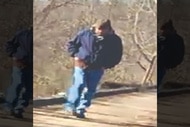‘It Was Horrendous’: Netflix's 'Catching Killers' On How The BTK Case Haunted Investigators
Dana Gouge, a Wichita Police detective who helped catch Dennis Rader, says in Netflix's "Catching Killers" that there are some things one cannot "unsee."

Detectives who helped solve the BTK Killer case are expressing how much the crimes weighed on them in a new episode of Netflix's “Catching Killers.”
Dana Gouge and Kelly Otis were homicide detectives with the Wichita State Police in 2004 when the BTK Killer — short for bind, torture, kill — reached out to both the department and the media through a letter. The police department then put together a task force.
The then-elusive killer — later determined to be Dennis Rader — had killed 10 people between 1974 and 1991.
Gouge said that the decades-old killings affected him as he tried to determine who was behind both the murders and the letter. He was, he tells "Catching Killers," disturbed by looking at the crime scene pictures of the 1974 murders of the four members of the Otero family, including a 9-year-old boy and 11-year-old girl.
“Josephine Otero was just 11 years old,” Gouge reflected. “I had kids at the time and I found it extremely disturbing looking at those pictures. It was horrendous. And you can’t unsee something, right?’
Otis noted that, as he worked to solve the case, he would regularly come home late with his mind swirling.
He told “Catching Killers” that he’d often try to drown out the heaviness of the case with “good whiskey” and “mindless” television shows. He said he’d try to sleep, but often it wasn't possible.
“So I'd get out of bed, shower, shave, put on a clean suit and go back to work," he said.
Numerous times, he’d get to work at 4:00 a.m. only to find other investigators on case already there, wide awake and talking theories at the office.
"Catching him was all you were driven to do,” Gouge said. “Living like that, you know, was difficult."
But that drive ultimately helped find the killer.
The investigators used Rader’s love for attention and tendency to want credit for his crimes to get him to communicate more with them, hoping he’d slip up — and that updated technology could get a hold on his identity.
Then, in 2005, he asked police if he could send them a floppy disk, but wanted to know if a disk would be traceable.
“Be honest,” the serial killer stated.
"The decision was made that we weren’t going to be honest with him,” Gouge told “Catching Killers.”
They told the serial killer — via a personal ad in the paper, as he requested — that it was safe.
Rader then mailed a floppy disk to police which, of course, contained encrypted metadata. That metadata pointed investigators to Rader.
Then, through his daughter's DNA, they were able to confirm his identity. He was arrested that same year.
Rader was ultimately convicted of 10 murders and is currently serving a life sentence at El Dorado Correctional Facility, a maximum security prison in Kansas.

























